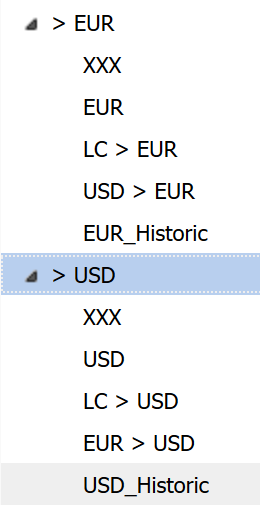Return to Financial Consolidation Model Overview.
Target currencies are base elements in the Target Currency dimension. Valid currencies must be represented by a code consisting of three capital letters, as defined by ISO 4217. All source currencies must be children of the total element All Target Currencies.
In addition to each target currency, several elements in the Currency dimension are required:
- For each combination of source currency (e.g.
USD) and target currency (e.g.EUR), a conversion element must exist. The naming convention for the conversion element is the source currency code followed by the sequence “blank – greater sign – blank” and the target currency code (e.g.USD > EUR). - For the trivial conversion, where source and target currencies are identical, no conversion element is needed.
- For the conversion of local currency to each target currency, another conversion element (e.g.
LC > EUR) must exist. - For each target currency, a total of all conversion elements must exist. The naming convention for this total is the sequence “greater sign – blank” and the target currency code (e.g.
> USD). Children of this element are:- the non-currency element (
XXX) - the source currency element to the target currency (e.g.
USD) - the conversion element of the local currency (e.g.
LC > EUR) - all conversion elements from any source currency (e.g.
USD > EUR) - the source currency element to the target historic currency (e.g.
USD_Historic)
- the non-currency element (
Note: after changing the target currencies, the rule templates handling the currency conversion in the fact cubes need to be updated.
Updated August 13, 2025
